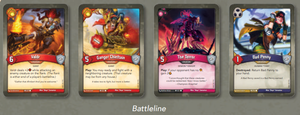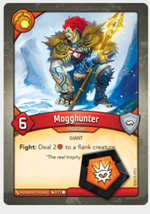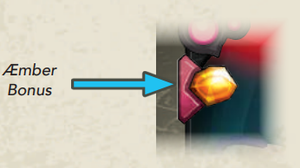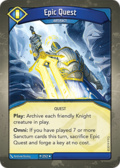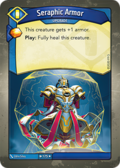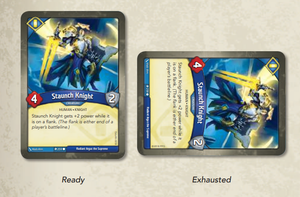How Do You Play KeyForge?
This guide is designed to give a basic overview of the main components and rules for KeyForge and is geared towards new players. Links to relevant rules sections are provided should more detail be needed.
The Play Area and Counters
As Archons race to collect Æmber to forge the 3 keys required to open the Vault, the creatures, artifacts, upgrades and actions are laid out in the play area. The play area consists of several zones:
Battleline
The Battleline consists of an player's creatures that they have in play. As creatures enter play, they are placed exhausted on either flank.
Artifacts
Artifacts are placed in a separate zone behind the battleline.
Archives
A player’s archive is a face down game area near that player’s Identity Card.
Deck
A Player's deck is kept face down next to the player's Identity Card. If the player is required to draw a card and their deck is empty, the player shuffles their discard pile to form a new deck.
Discard
The discard pile is a face up area near the player's deck. The cards in a player's discard pile is considered open information; either player may look at a player's discard pile at anytime.
Purge
The Purge zone is a face up area under the player's Identity Card. Cards that are in the Purge zone no longer interact with the game in any way.
Keys
At the beginning of the game the three key tokens are placed with their unforged side up. When a key is forged, the forging player flips the token to the forged side. The first player to forge all three of their keys is the winner.
Identity Card and Æmber pool
A player's Identity Card shows the name of the Archon that they are playing during the game as well as the Houses that their deck contains. The Identity Card also serves as the player's Æmber pool.
Common Pool
Æmber and other tokens that are not currently being used in the games are kept outside of both player's play areas, but within easy reach for when they are needed.
Counters
Æmber
Æmber is the currency of KeyForge. Players collect Æmber by playing cards with Æmber Bonus icons or reaping. Player's keep their Æmber in a pool on their Identity Card.
Damage
Damage counters are used to track the amount of damage a creature has taken. Damage does not affect a creature's power.
Enrage
Enraged Counters indicate that a creature must fight when used, if able.
Power Counters
Power Counters are used to increase a creature's power.
Stun
Stun counters indicate that a creature cannot be used to Reap, Fight, or resolve Action: or Omni: abilities.
Ward
Ward counters prevent the creature from taking damage or from leaving play.
Other counters
Some cards in KeyForge have specific abilities that utilize other counters. The card ability describes how that counter works.
Card Anatomy, Abilities, and Keywords
House
An Archon deck is made up of 36 cards, 12 cards from each of three Houses. The House symbol for a card tells you what house the card belongs to and is located in the upper left corner of the card.
Bonus Icons
Many cards have one or more bonus icons in the upper-left corner, below the house icon. They are resolved in order from top to bottom. There are four types of bonus icons:
Æmber (![]() ): Gain 1 Æmber.
): Gain 1 Æmber.
Capture (![]() ): A friendly creature captures 1 Æmber from the opponent. This Æmber may be captured by any friendly creature, including the creature with the capture icon. If a card has multiple capture icons, the captured Æmber may be distributed among multiple creatures.
): A friendly creature captures 1 Æmber from the opponent. This Æmber may be captured by any friendly creature, including the creature with the capture icon. If a card has multiple capture icons, the captured Æmber may be distributed among multiple creatures.
Damage (![]() ): Deal 1 damage to a creature in play. This damage may be dealt to the creature with the damage icon. Damage dealt by a bonus icon is not considered to be dealt by the card on which the icon appears.
): Deal 1 damage to a creature in play. This damage may be dealt to the creature with the damage icon. Damage dealt by a bonus icon is not considered to be dealt by the card on which the icon appears.
Draw (![]() ): Draw 1 card.
): Draw 1 card.
Types
There are four types of cards in the game: action cards, artifacts, creatures, and upgrades. There are different rules describing how each card type is played.
Power and Armor
For Creatures, the number in the red diamond on the left indicates the creature's power. The number in the grey shield on the right indicates the amount of armor the creature has.
Traits
Traits are descriptive attributes (such as “Knight” or “Specter”) that maybe referenced by other cards. Traits are listed at the top center of a card’s text box. Traits have no inherent game effect, but may be referenced by card abilities.
Keywords
Keywords are a special class of card abilities. A complete list of keywords and what they do can be found here.
Abilities
The text that appears below traits (and Keywords, if a card has them) are known as abilities.
An ability is the special game text a card contributes to the game. Unless an ability explicitly references an out-of-play area (such as a hand, deck, archives, or discard pile), that ability can only interact with cards that are in play. Abilities that interact with a card after it is destroyed can interact with that card while it is in the discard pile.
Play:
For creatures, artifacts, and upgrades, the Play: ability resolves after the card enters play. For action cards, the Play: ability resolves, and then the card is immediately placed in its owner’s discard pile.
After Reap:
Any ready creature of the active house can Reap. After using a creature to reap, After Reap: abilities resolve.
Before Fight: and After Fight:
Before Fight: abilities resolve after the attacking creature is exhausted and the target of the fight is chosen. After Fight: abilities resolve after the Fight has completed.
Action:
Action: abilities resolve after a player exhausts a card and chooses to resolve an Action: ability.
Omni:
Omni: abilities resolve after a player exhausts a card and chooses to resolve an Omni: ability. The card with the Omni: does not have to belong to the Active house.
Constant abilities
If a card has an ability that does not have a boldfaced precursor, the ability is a constant ability that is active so long as the card remains in play and meets all conditions specified by the ability.
The Turn
Forge a Key
If the active player has enough Æmber to forge a key during this step, they must do so. When a key is forged, flip a key token from its unforged side to the forged side. A player wins the game when they forge their third key. Æmber that is spent forging keys is returned to the common supply.
Choose a House and pick up Archives
The active player chooses one of the houses on their identity card to activate, making it the active house for the remainder of the turn. This active house determines which cards the active player can play, discard from their hand, and use this turn.
After choosing a house, the active player has the option to take all cards in their Archives and add them to their hand.
Play, Use, Discard cards
The active player may play or discard any number of cards of the active house from their hand and may use any number of cards of the active house that are in play under their control. Eligible cards may be played, used, or discarded in any order. More on how this step works in the next section.
On the first turn of the game, the Active player cannot play or discard more than one card from their hand.
Ready Cards
Any cards that are exhausted, either from entering play or being used are set to the ready orientation.
Draw
The active player draws cards from the top of their deck until they have six cards in their hand. After a player completes this step, their turn ends.
- If the active player has more than six cards in hand, they do not discard down to six.
- If a player needs to draw cards (during this step or at any other time) and cannot because their deck is empty, that player shuffles their Discard Pile to reset their deck, and then continues to draw. (Cards are drawn one at a time).
- When a player’s turn ends, if that player has enough Æmber in their pool to forge a key, the player announces “Check!” so that their opponent knows the forging of a key at the start of that player’s next turn is imminent.
Discarding, Playing, and Using Cards of the Active House
During Step 3 of the turn, the active player can discard, play, or use eligible cards of the active house. The player can do these things in any order, and may repeat these things in the sequence of their choice. For example, they might play a card, discard a card, play another card, use a card, etc.
Discard
The active player may discard any number of cards of the active house from their hand during step 3. Cards are discarded one at a time and can be discarded at any time during the step.
Play (by type)
The active player may play any number of cards of the active house from their hand during step 3. Cards are played one at a time and can be played at any time during the step.
Bonus Icons and Play: abilities
After a card with a bonus icon is played, the first thing the active player does is resolve each bonus icon on that card. These icons are resolved after the card enters play (if it is an artifact, creature, or upgrade), but before resolving any Play: abilities on that card or any abilities that resolve “after” that card is played.
Some cards have a bold Play: ability. Such abilities resolve after the card’s bonus icons are resolved, if it has any, and after the card enters play.
Ready and Exhausted
All creatures and artifacts enter play exhausted. Exhausted cards are rotated 90 degrees to the side. An exhausted card is not able to be used until it is readied by a game step or card ability.
Creatures
Creatures enter play exhausted and are placed in the front row of the active player’s battleline. Creatures remain in play from turn to turn, and they each have power and armor values that they use to resolve fights.
Each time a creature enters play, it must be placed on a flank—at the far left or the far right of its controller’s battleline.
Artifacts
Artifacts enter play exhausted and are placed in a row in front of the player but behind that player’s battleline. Artifacts remain in play from turn to turn.
Actions
When an action card is played, the active player resolves the card’s Play: ability and, after resolving as much of the ability as possible, places the card in their discard pile.
Upgrades
Upgrades enter play attached to (i.e., partially overlapped by) a creature chosen by the player who controls the upgrade. Each upgrade remains in play from turn to turn and modifies the card to which it is attached.
- If the card to which an upgrade is attached leaves play, the upgrade is discarded.
- If an upgrade cannot attach to a card in play, the upgrade cannot be played.
Use
The active player can use any number of cards from the Active house that they have in play during step three of their turn.
Reap
Any ready creature of the active house can reap. After exhausting the creature, the active player gains 1 Æmber. Then, all After Reap: abilities the creature has, if any, are resolved in the order of the active player's choosing.
Fight
More details on Fighting are in the next section.
Any ready creature of the active house can fight. When a creature is used to fight, the active player exhausts the attacking creature and chooses an eligible creature in the opponent's battleline to attack. After choosing the creature to attack, the active player resolves any "pre-fight" abilities (such as Before Fight: and keywords (such as Assault and Hazardous) in the order of their choosing. Then, the attacking creature and attacked creature simultaneously deal damage to one another based on their power. After this damage exchange, if the attacking creature is not destroyed, any After Fight: abilities the creature has are resolved in the order of the active player's choosing.
Resolve Action: and Omni: abilities
Any ready card of the active house may be used to resolve its Action: ability, if it has one. When a card is used to resolve its Action: ability, the card exhausts and that “Action:” ability resolves.
Any ready card may be used to resolve its Omni: ability, if it has one, even if it does not belong to the active house. When a card is used to resolve its Omni: ability, the card exhausts and that Omni: ability resolves.
Stun
While a creature has a Stun token on it, it cannot fight, reap, or be used to resolve Action: or Omni: abilities. Any time a stunned creature could normally be used, it can instead be used by exhausting it to remove its Stun token.
Pre-Fight Abilities and Fighting
When a creature is used to fight, the active player exhausts the attacking creature and chooses a creature in the opponent's battleline to fight.
Assault, Hazardous, Before Fight
After choosing a creature in the opponents battleline to fight, the active player resolves any "pre-fight" abilities or keywords in the order of their choosing. This includes Before Fight: abilities, Assault, and Hazardous.
If the attacking creature has multiple "pre-fight" abilities, all of them will resolve, even if the attacked creature is destroyed by a preceding "pre-fight" ability.
If either the attacking or attacked creature is destroyed by a "pre-fight" effect, the fight (damage exchange via creature power) will not occur. Post-Fight abilities may be available to be resolved.
If a creature with the Assault keyword attacks a creature who has the Hazardous keyword, the active player chooses which keyword resolves first. If the creature is destroyed by the Hazardous effect before the active player resolves the Assault keyword, the Assault is not applied. Similarly, if the creature is destroyed by the Assault keyword before the active player resolves Hazardous, the Hazardous is not applied.
Damage Exchange via Creature Power
If neither the attacking creature or the attacked creature are destroyed by a "pre-fight" ability, then the two creatures deal damage equal to their power to the other creature.
Post-Fight Abilities Resolve
Card effects that reference “after a creature fights” or “after a creature is used” resolve, even if the fight (Damage exchange via creature power) did not occur. These resolve in the order of the active players choosing.
If the attacking creature is not destroyed after the damage exchange via power, the active player also resolves any After Fight: abilities the creature may have. These abilities resolve in the same window as "after a creature fights" and "after a creature is used" abilities, and the active player chooses the order in which they resolve.
Damage, Damage Mitigation, and Destruction
Damage that is taken by a creature is tracked by placing damage tokens on the creature. Damage does not effect a creature's power.
Damage Mitigation
When an effect deals damage to a creature the damage is mitigated by the following, in this order:
- Abilities or Keywords that prevent damage (e.g. Invulnerable, card abilities like Shield of Justice)
- Remove a Ward to prevent damage from being dealt (A ward will protect a creature from a single "wave" of damage, no matter how much damage is in that wave.)
- Reduce Armor to prevent damage. Armor prevents an amount of damage equal to the armor value that the creature would take each turn.
After mitigating the damage, any remaining damage is dealt to the creature and tokens are applied. If a creature has damage equal to or greater than its power, the creature is Destroyed.
Destruction
A card my be destroyed by a card effect or a creature having damage greater than or equal to its power. When a card is destroyed, first it is "tagged" for destruction, then any Destroyed: abilities the card has resolve, and finally, the card leaves play and is placed in its owner's discard pile.
If multiple cards are destroyed at the same time, the cards are simultaneously tagged for destruction and the Active Player chooses the order in which Destroyed: abilities, if any, resolve. If a Destroyed: ability results in further cards being destroyed, the active player will also determine the order of how any further Destroyed: abilities may resolve. Once no further Destroyed: abilities can be resolved, all cards that are tagged for destruction leave play and are placed in the discard piles of the respective owners. All cards leave play simultaneously, but the active player can choose the order in which they are placed in the discard pile. Once all the cards have been placed in the discard pile, any "After a creature is destroyed" abilities on cards that are in play are resolved.
The Timing Chart
While this quick overview of the rules should be enough to get you started playing KeyForge, the Timing Chart provides a handy reference for when abilities can be resolved. If multiple abilities are available to be resolved in the same window, the Active Player decides the order in which they are resolved.

